In Scotland The SNP has been responsible for the NHS since 2007. In Wales Labour has run it since 1999. In England its now Labour, after the Liberals and Tories had their turn. So how do they all compare? Here’s a clue – one delivers consistently better performance than the rest. Although they’ve all suffered from Westminster austerity and COVID.

Let’s look at some key performance measures. These are the ones the British media and politicians likes to quote most frequently:
- A&E Waiting Times
- Cancer Mortality
- GP numbers.
It’s worth noting that whilst England, and to a lesser extent Wales, are amongst the most densely populated nations in Europe: Scotland is one of the least populated. Providing effective healthcare in rural areas is a particular challenge.
At the end I look at how satisfied people say they are with local health services. Its fare to say that this satisfaction reflects the results from these key performance indicators – but, at least in Scotland, does not reflect what the British media tells us.

Tldr; if you just want the answer, and not the detail, it’s The SNP in Scotland. I live in the Borders of Scotland. So as well as each nation’s performance I’ve also included performance for my local area.
My area is semi-rural/rural and one of the less affluent areas of Scotland. It’s variously shown here as “MSTL” (Midlothian South, Tweeddale, and Lauderdale), Scottish Borders, and Midlothian – depending on the data source.
A&E Waiting Times
The most frequently quoted measure of A&E performance is the proportion of people attending A&E who are dealt with within 4 hours. This chart compares the pre-COVID 2020 performance of each nation with the latest data from March 2025.
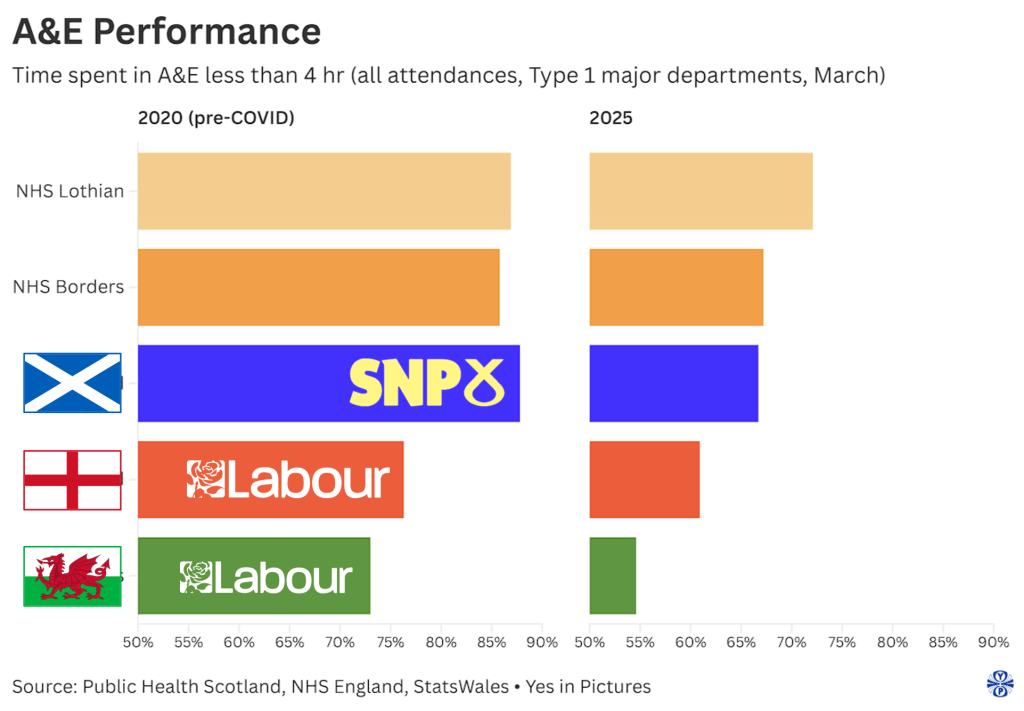
It’s clear that NHS Scotland performance remained significantly better than that of the NHS in England or Wales, both before and after COVID. In Scotland the NHS is organised around local Health Boards: my local ones are NHS Lothian and NHS Borders.
Interestingly, it was this Health Board structure that particularly came into its own during COVID. Rather than Westminster’s hugely costly and somewhat less effective centrally-directed test and trace approach, in Scotland the SNP devolved responsibility to each Health Board. These Health Boards were already experienced in vaccine work and delivered a more successful approach at vastly lower cost than in England (and without that corrupt “VIP Lane”).
But I digress.
If we look at the more detailed trends in A&E performance its clear that the NHS in SNP Scotland has consistently performed better than the NHS in Labour Wales. However the dramatic drop in England’s performance, compared to Scotland, coincides with the early years of the Lib Dem/Tory reign in Westminster – and its introduction of austerity measures.
Funding for the NHS flatlined.
For those who understand Scottish Government funding, you’ll be aware that Westminster decides what proportion of the public revenues it collects from Scotland get returned to Scotland. And this can be significantly impacted by what priorities on spending it is applying in England.
So when Westminster decided to flat-line NHS spending in England, this hit Scottish (and Wesh) budgets too. Unlike Westminster, Scotland has no sovereign ability to create money for investment – so the Scottish Government is obliged to work within the budget set by Westminster.
How then did Scotland maintain NHS performance, whilst England and Wales performance plummeted? The Scottish Government did not apply all those Tory “reforms” that NHS England suffered. It didn’t waste money on costly privatisations, large scale ideologically driven reorganisation, or pointless wars with NHS staff. It got on with refining an already working model, whilst applying progressive best practices learnt from across Europe.
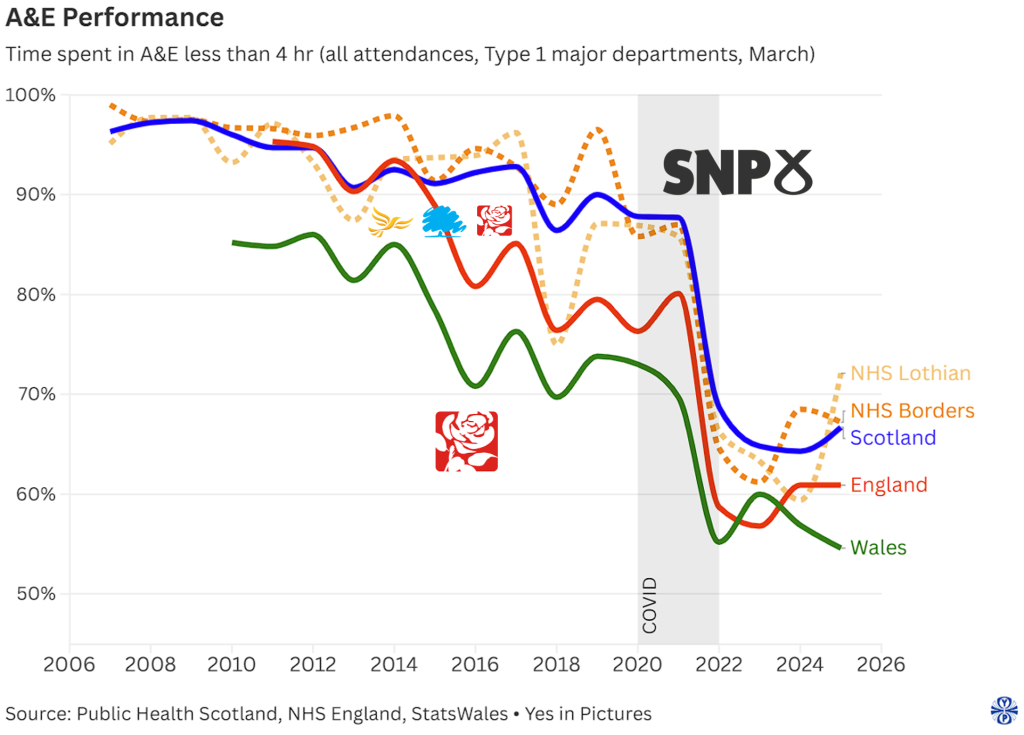
Cancer Mortality
Cancer is a major cause of premature death in Great Britain, particularly for adults, though it is not the leading cause of death overall, which is dementia. There are many different types of cancer – and many can be addressed successfully or avoided completely if we concentrate on healthy lifestyles and early detection.
In Scotland there has been much work done on this avoidance and early detection. The result is that mortality rates in Scotland have been falling much more quickly than in England and Wales. However in my rural area – the Scottish Borders – Labour has actually performed better when comparing this with the Welsh national norm.
This partial good news needs to be tempered though. If we compare a like-for-like rural area of Wales like that covered by the Hywel Dda Health Board, then Labour is delivering a performance level more comparable to that in England.
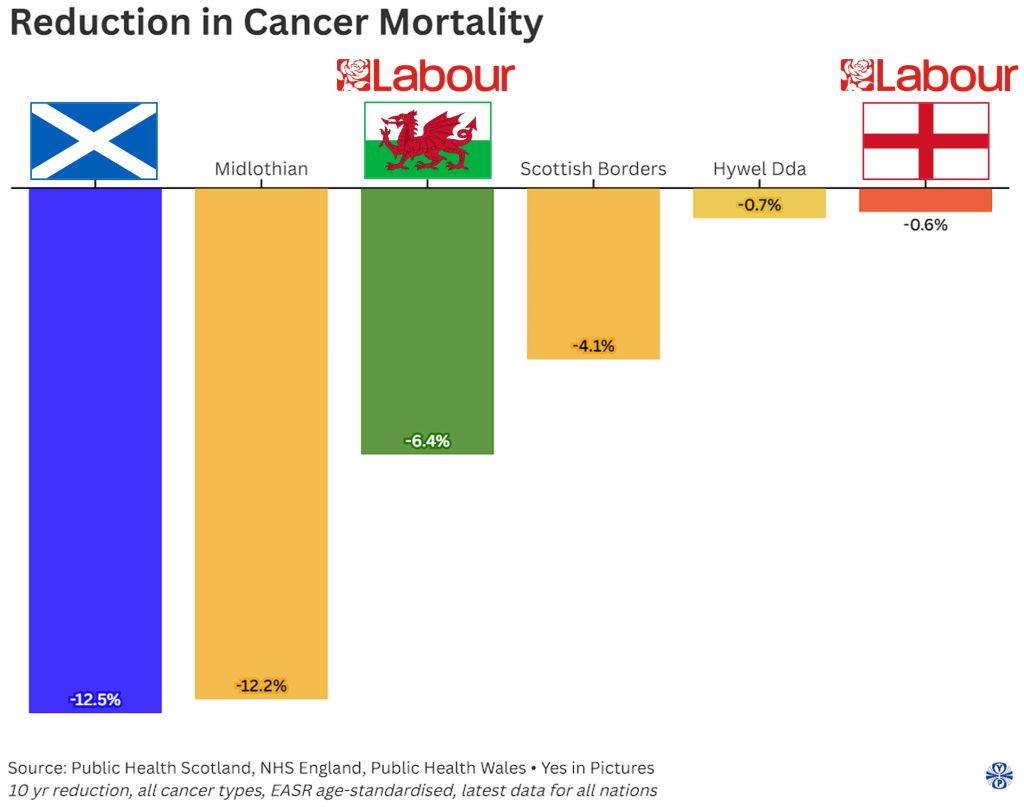
The latest year that data is available from all nations is 2020. Cancers affect different ages and sexes differently, so a “European age-standardisation” method is applied to allow us to compare all cancers across the full population.
GP Numbers
Westminster has introduced a somewhat unpopular new “GP Contract”. This dictates how GPs are paid by the NHS – they effectively operate as private contractors to the NHS. This is a relic of how the NHS was originally set up after WWII. It was felt at the time that bringing GPs fully into the NHS was a step too far (code for “they made a lot of noise against it”). As a result GP relationships with the NHS are complicated.
In Scotland much work has been to done to bring GPs into the NHS model, despite this contractual complication – and as a result the “GP Contract” in Scotland is quite different to the one in England. There is much more focus on treating the GP as a key part of an integrated community health team that includes hospitals and other community health care groups.
The latest move in this direction is the construction in Scotland of one-stop community health hubs such as that newly opened in Parkhead including GPs and other health and community professionals under one roof. Its one outcome that typifies the SNP’s holistic Wellbeing Economy approach.
These differing approaches can be seen in how GPs have been trained and retained by the different NHS organisations. Scotland has significantly more GPs in relation to its population size than England. Even Wales is more successful in this respect.
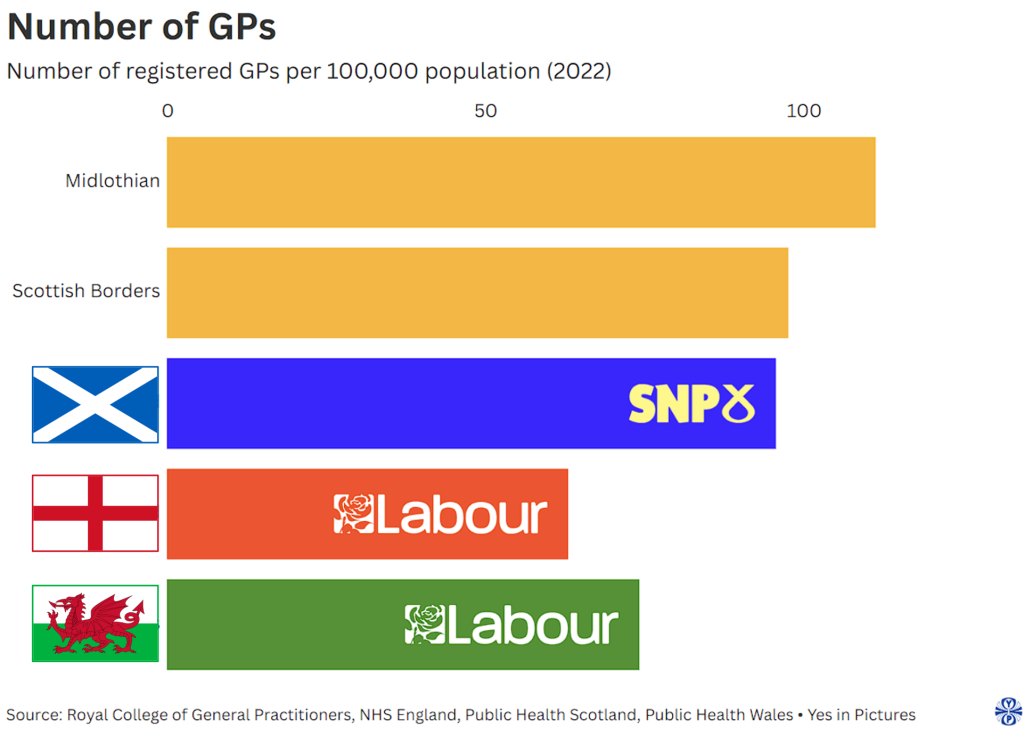
Looking at the long term trend, it’s clear that Westminster has failed to address GP numbers for many years.
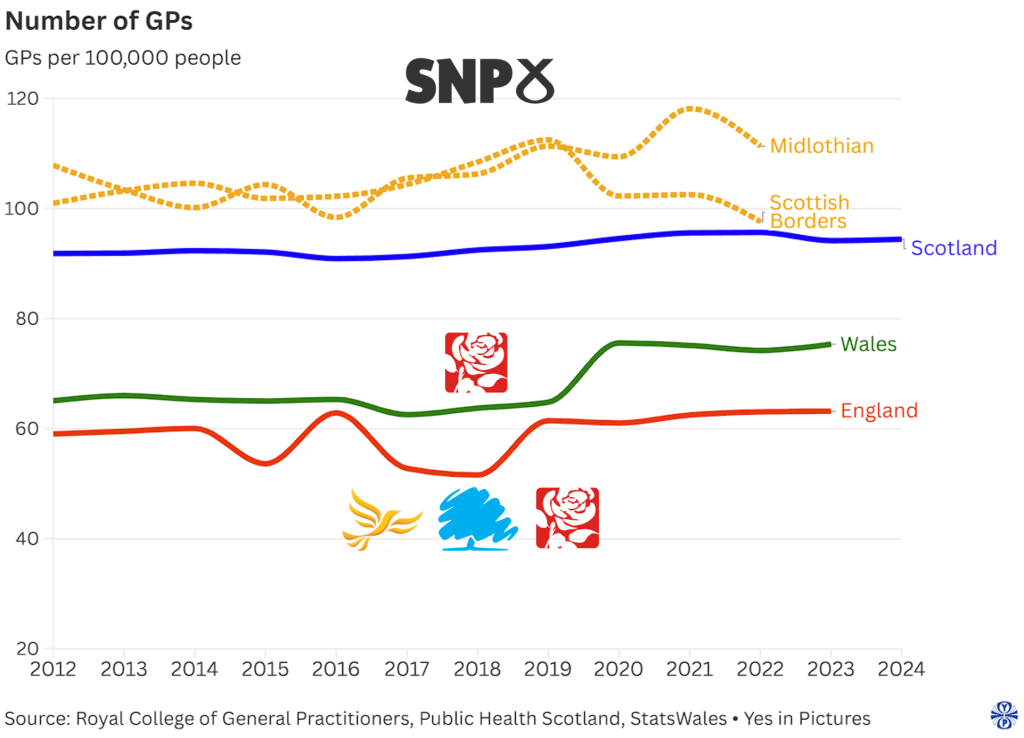
Satisfaction
This comparison looks at how satisfied people say they are with their local health services. It’s no surprise that, across all nations, people are less satisfied now. This drop coincides with the long-term enforcement of Westminster austerity and flat-line spending on the NHS that came with it. It is accelerated by the aftereffects of COVID, as health services attempted to deal with the COVID backlog from an already stretched capacity to deliver.
But despite these pressures, Scotland has continued to outperform England and Wales.
In fact Britain – i.e. most predominantly England – has declined enormously. Here “Britain” is compared to Scotland, as individual national data is not publicly available for England and Wales. This chart shows the Scotland norm, together with the least/most satisfaction in local authorities across Scotland – together with my two local areas.
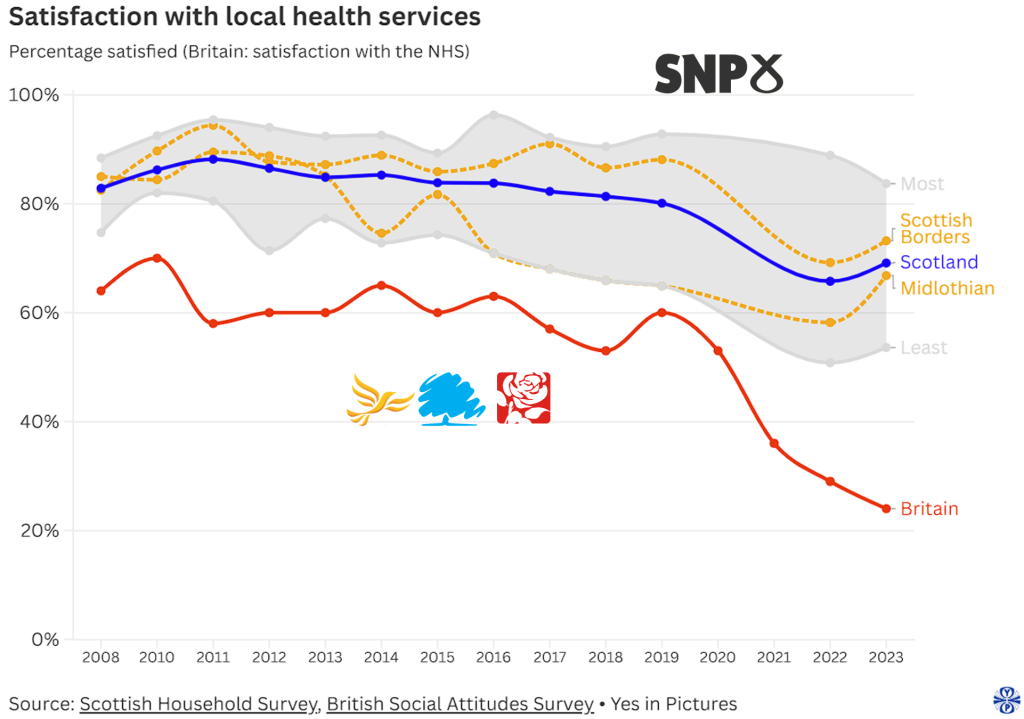
The impact of Westminster
Now imagine if Westminster austerity hadn’t been inflicted on Scotland. Going in to COVID Scotland’s NHS would have continued to receive its pre-2010 levels of investment. We would most probably have seen a consistently high performance level – which was running at almost 90% satisfaction in 2010.
After COVID there would undoubtedly have been a drop – but on this basis it would still be running at around 80% satisfaction. The NHS would be recovering much more quickly.
The only thing that will remove Scotland permanently from the damage of Westminster, and further unnecessary damage to our NHS, is regaining independence.

Leave a Reply